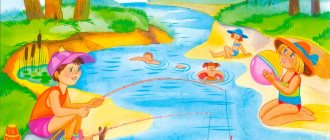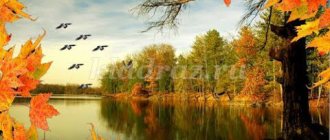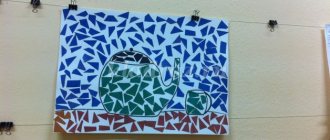Summary of educational activities in the senior group of the preschool educational institution “Winter Fun” (composing a story based on a picture)
- January 3, 2021
Program content:
- Improve children's ability to write a descriptive story based on a picture.
- Strengthen the ability to present the content of a picture in detail and logically; independently invent events preceding and following those depicted in the picture.
- Practice composing sentences and incorporating them into a coherent statement.
- To develop children's coherent speech in story writing, attention, and memory.
- Develop the ability to listen to the answers of your comrades to the end, without shouting.
Materials and equipment: painting “Winter Fun”, stereo system, DVD with music by A. Vivaldi “Winter”, board, magnets. Preliminary work: conversations with children about winter and winter activities, selection of definitions, selection of synonyms for the word quickly - swiftly, dashingly, at full speed, like an arrow, in an instant, immediately, etc.
GCD move
Educator: Guys, let's guess the riddle and find out what we will talk about. So listen to the riddle.
I dusted the paths, decorated the windows, and gave joy to the children. And I went for a sledding ride. (Winter).
A short conversation on the following questions:
- Guys, what is this riddle about? (About winter).
- What is our winter like? (Severe, white, silver, fluffy, snowy, frosty, cold).
- What happens in winter? (Snow is falling, the wind is howling, rivers are freezing).
Well done guys, you remembered all its signs.
Exercise “Name the action” (with a ball).
Educator: I will say an unfinished sentence, and the one to whom I pass the ball will finish the word I didn’t say.
- In winter there is a snowstorm... (sweeping).
- At night the wind in the pipes... (howls, howls).
- From a snow cloud, snowflakes... (fall, fly, spin).
- There is a hungry wolf in the forest in winter... (howls).
- For the winter, the bear is in a den...... (falls asleep).
- Frost on the cheeks and nose... (stings).
- In winter, the water in the river... (freezes).
- Frost on tree branches... (glitters).
- In winter, snow is all around... (covers).
- Trees in winter... (sleep).
- Grass under the snow in winter... (warming up).
- In winter, insects... (hide).
Well done! You know winter phenomena well. Do you know what winter cannot be without? Let's continue playing.
Game "Third Man".
Educator: Now listen to my winter words, one of the three words will be superfluous, you need to name it, explaining your decision:
1. January, February, winter.
2. Snowballs, sleds, skates.
3. Blizzard, skiing, frost.
4. Snowball, snowman, bullfinch.
Right! What smart people and smart girls! You know everything about winter and winter phenomena. Guys, do you think winter is good or bad?
Suggested children's answers:
- It’s good in winter because there is a lot of snow and you can build a snowman and have snowball fights.
- It’s good in winter, you can sled down the mountain.
- In winter comes the best holiday - New Year, and this is very good.
- It’s bad in winter, when it’s very cold, we don’t go for walks.
- Birds feel bad in winter - they are cold and have nothing to eat.
- In winter it’s nice and fun, we go skiing and play hockey.
For each answer, the teacher draws a circle of snowballs “good”, “bad”.
Educator: Guys, look at the snowballs and draw a conclusion: which snowball is bigger? There are more good things in winter: the kids love to play, have fun, and play sports.
But what games do they like to play? I'll tell you some riddles :
My new friends are both brilliant and light, And they frolic with me on the ice, and are not afraid of the frost. (Skates).
They run forward with their noses in the air. Two stripes follow them. (Skis).
Oh, it's snowing! I'm bringing out my friend horse. I fly down the hill on it, and drag it back. (Sled).
Physical exercise.
- “Winter has finally come, (children spread their arms to the sides)
- The houses have become white (they fold their hands over their heads)
- It's snowing outside (move hands from top to bottom)
- A janitor sweeps the street (imitate)
- We are sledding (squat, arms extended forward)
- We write circles on the skating rink (put our hands behind our backs and spin slowly)
- Skiing deftly, (imitate)
- And we all play snowballs. (They make and throw snowballs)"
It's good in winter - a lot of games and fun. What can you do in winter? (Sledding, skiing, skating, building forts, making snowmen, etc.).
Dynamic pause.
Educator: Now we will play. You (points to half of the group) will be snowflakes, and you (the other half) will be the wind. The game is repeated twice, the subgroups change roles. Snowflakes are spinning, running on tiptoes, the breeze is resting. As soon as I say “the breeze has woken up,” the breeze blows, shhh, and the snowflakes settle.
Didactic ball game “Name it kindly”
(Children catch the ball, give answers to the teacher with a diminutive suffix):
- Snow - snowball
- wind - breeze
- star – asterisk
- winter - winter
- Christmas tree - Christmas tree
- snowflake - snowflake
- sun - sunshine
- snowman - snowman
- star - asterisk.
Educator: Many poets, writers and artists depicted winter in their works. And in our art gallery there is a picture about winter. (The teacher draws the children’s attention to the painting “Winter Fun”).
Educator: In a real art gallery there is a guide who tells all visitors interestingly about the paintings. Do you want to try to become a tour guide, compose and tell a story based on this picture?
Communication by picture:
- What time of year is shown here?
- Why did the children come to the hill, and what happened there?
- What were the children doing? (Children sledding down the mountain, making a snow woman, skiing, playing snowballs).
- How do the guys play in winter? (Fun, joyful, friendly, interesting, fervent).
- At the end of the story, tell me what mood the guys were in and why you decided that way.
– Remember the words that will decorate your story and make it interesting. Do not forget that children can be called differently when telling stories (children - kids, guys, boys and girls, they).
Children's stories based on the picture.
Reflection.
- What did we do today? You did your best today and made up different interesting stories. It seems to me that this story will be interesting for your moms and dads to listen to at home.
As a farewell gift, I want to give you pictures – “Winter Fun” coloring pages. Winter has only white paint, but you can color them with your colored pencils.
Author: Gumerova Rezeda Khalidovna, teacher at MBDOU DS KV “Beryozka”, Novy Urengoy, Tyumen region.
Lesson summary: story based on a picture; plan-summary of a lesson on speech development (senior group) on the topic
GBOU School No. 1080
Writing a story
based on the painting “We are on duty”
Moscow
2017
Target:
- develop the ability (based on a model) to compose a story based on a picture.
Tasks:
- expand your understanding of tableware, its purpose, the details and parts of which it consists;
- cultivate feelings of empathy (the desire to help a friend).
Educational area:
- Communication (connected speech).
Integration of educational areas:
- Cognition (Formation of a holistic picture of the world, broadening one’s horizons)
- Socialization (Introduction to basic generally accepted norms and rules of relationships)
Forms of direct educational activities:
- cognitive-research (games with rules, examination), communicative (conversation, leading dialogue, situational conversation), gaming (games with rules, didactic games).
Forms of organization:
- subgroup.
Preliminary work:
- observation of those on duty at sensitive moments.
Equipment, tools, materials:
- magnetic board, picture “We are on duty”, subject pictures about dishes.
Progress of direct educational activities:
Organizing time.
Game "Name the first sound." Develop phonemic awareness.
The teacher invites the children to take seats next to the chairs.
Educator. The one who names the first sound in the word jug, knife, ladle, plate, mug will sit down.
Children take turns naming the first sound in words.
Educator. Think and say, in one word, what we will talk about today.
Children. About dishes.
Educator. What are the dishes for?
Children. Food is prepared and stored in dishes, and food is eaten from dishes.
Game “Don’t yawn and name the dishes.” To develop children's knowledge about tea, table and kitchen utensils.
The teacher names the dishes, and the children determine what type they belong to.
Looking at the painting. Teach children a holistic perception of the picture, develop dialogical speech.
Educator. This painting is “We are on duty.” Why do you think it is called that?
Children. The picture shows children. They are setting the table. Children are on duty in the dining room.
Educator. Talk about the children who set the table. How are they dressed? What are they holding in their hands?
Children. A girl in short blue pants, an orange T-shirt, and a white apron. She has two braids. She holds spoons in her hands. A boy in brown trousers, a green T-shirt, and a white apron. He has dark short hair. He puts a plate on the table.
Educator. What have they already put on the table?
Children. They covered the table with a white tablecloth, placed a bread box with bread and cups and saucers.
Educator. What dishes are on the table? Describe her. Use words that answer the question “Which one?”
Children. There are cups, saucers, a plate, and a bread box on the table. They are earthenware, bright red, new.
Educator. Who else is in the picture? What are they doing?
Children. Children and a teacher are sitting near a bookcase. The teacher reads a book to the children.
Educator. Tell us about the mood of the teacher and the children.
Children. They are in a joyful mood.
Physical exercise “Teapot”. Develop coordination of speech and movement.
I am a teapot, a grumbler, a busybody, a madman, (Children stand with one hand bent like the spout of a teapot, the other held on their belt) I am showing off my belly to you. (Tummy is inflated) I’m boiling tea, bubbling and shouting: (They stomp with both feet) - Hey, people, I want to drink tea with you. (Make inviting movements with their right hand)
Compiling a story based on a picture. Develop coherent speech.
Educator. Now you will compose a story based on the picture, according to the following plan.
What is the name of the painting and why is it called that?
Describe the people on duty. What are they? How are you dressed? What do they have in their hands? What are they doing? What's already on the table?
Then you need to talk about the teacher and other children.
What's their mood?
Children compose a story in parts, then repeat the story by one of the children.
The result of direct educational activities. (Assessment of children's work).
The teacher invites the children to talk about what they did today, what games and exercises they liked, who did the best, and who needs to be more active and attentive.
Summary of a lesson on teaching storytelling based on a series of paintings in the senior group
Summary of a lesson on teaching storytelling from a series of paintings in the senior preparatory group
Topic: Teaching storytelling from a series of paintings. Goal: To teach children to compose a coherent story based on a series of paintings. Program content: 1. Develop coherent speech skills, the ability to work with visual material, the ability to work independently and in a subgroup. Strengthen the ability to work with mnemonic tables. 2. To develop the skills of composing a consistent, coherent, colorfully decorated story based on a series of paintings. Continue to teach children to do correct, well-founded self-analysis of their activities. 3. Cultivate a respectful attitude towards peers, careful attitude towards visual materials. Materials: mnemonic tables for compiling a descriptive story;
cards-schemes for the game “What happened first, and what then?”; two sets of pictures with a general plot; “Traffic lights” for self-analysis, Dunno doll, gift pictures. Progress of activities:
Children, Dunno came to us today.
Let's greet him. (children greet the character) Dunno is upset that he does not know how to write a beautiful, coherent story and thus cannot brag to his friends. Do you guys know how to come up with stories? What about the stories based on the painting? What about a series of paintings? I invite you today to learn how to write a story based on a series of paintings. And Dunno will learn this with us. But first, in order for our tongue to work well, I suggest you do articulatory gymnastics (children, together with the teacher, perform several exercises, sit on chairs in a semicircle). Now let’s do a little mental exercise “Guess the animal from the description . (children, if desired, compose a descriptive story about any animal without naming it, while relying on mnemonic tables) Dunno: Well done, what good riddle stories you have come up with. Now let's play the game “What happened first, and what then?” (children take cards-schemes, establish a sequence and talk about what they did, Dunno praises the children) Physical education (the teacher briefly tells the fairy tale, the children, standing in a circle, depict its heroes) Children, now I suggest you divide into two subgroups, go to the tables on which there are a series of paintings and together arrange them in the required sequence, then together come up with a story based on them and tell Dunno and me. To make your story consistent, decide which of you will start, who will continue, and who will finish the story. To make the story colorful and exciting, use complete sentences, detailed phrases and beautiful words. Remember that you have one plot in your paintings and therefore you must talk about the development of this plot, about what happened there (children work in subgroups, then tell their stories in subgroups, the teacher praises the children, makes corrections if necessary, Dunno marks the one he likes the most) story). Guys, go to your chairs, take the “Traffic Lights” and evaluate your activities: if you liked writing the story and you coped with everything - show green, if something seemed uninteresting or difficult - yellow, if you didn’t like anything at all - red (the teacher corrects the children’s work, notes the most active ones, Dunno thanks the children for their help and gives them pictures).
We recommend watching:
Summary of educational activities in the senior group “Journey to a Fairy Tale” Summary of a mathematics lesson for children of the senior orthopedic group Summary of educational and gaming activities in the senior group in the section of the “Childhood” program Synopsis of educational activities for the perception of music in the senior group of kindergarten
Similar articles:
Lesson in the senior group of kindergarten on the topic of February 23
Lesson notes for children of senior preschool age. Topic: Invisible air
Summary of organized educational activities for children of the senior group
Notes for mathematics classes in the senior group
Lesson summary on the topic “Reserve” in the senior group





